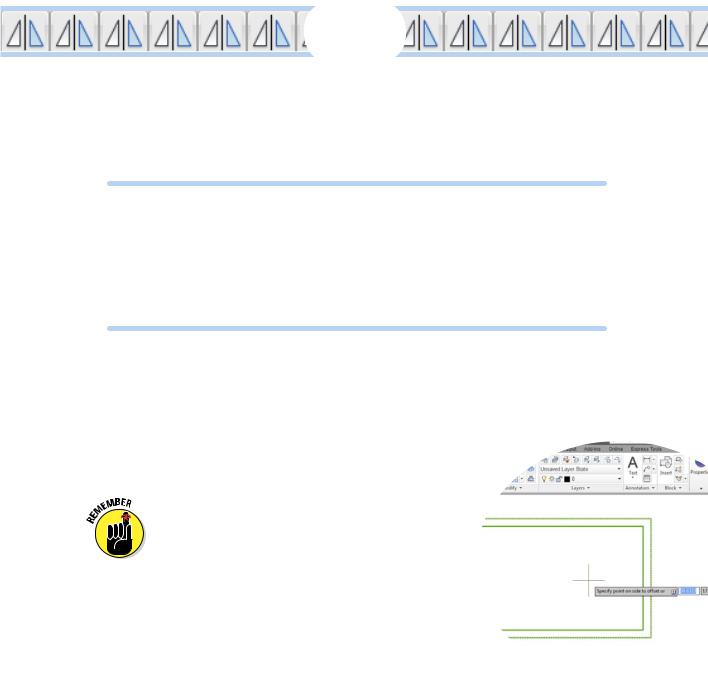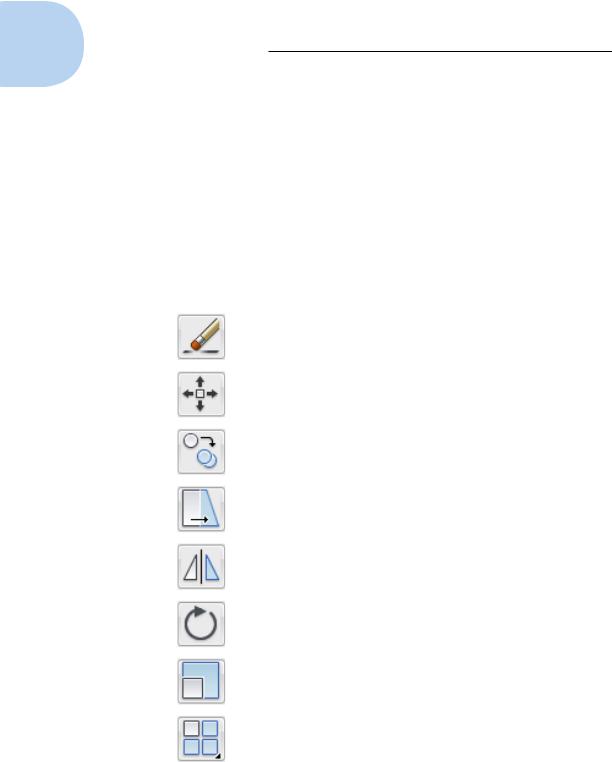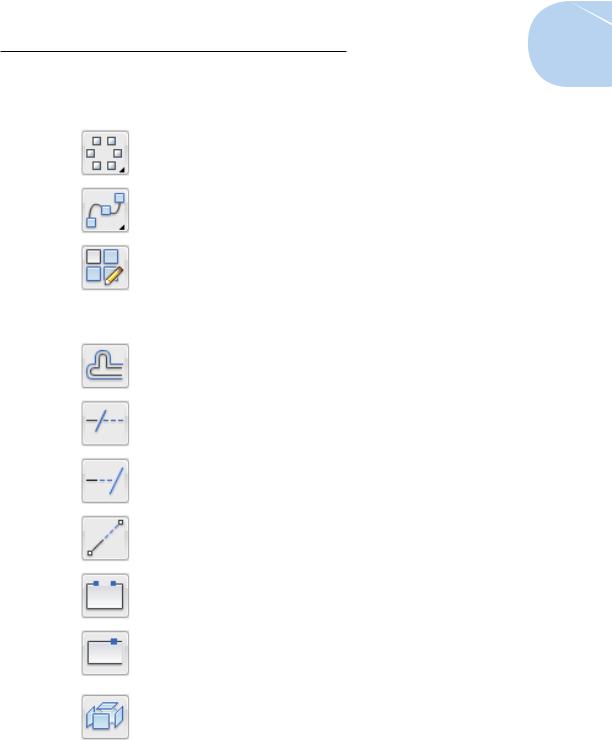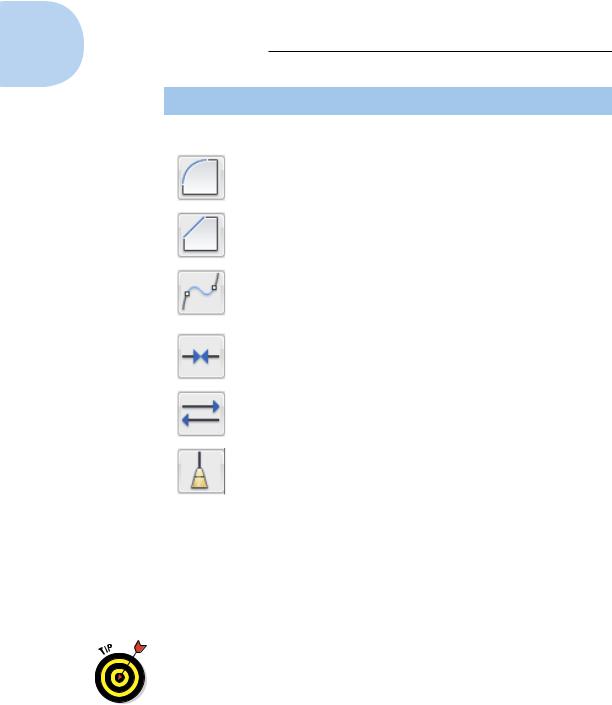
- •About the Authors
- •Dedication
- •Authors’ Acknowledgments
- •Table of Contents
- •Introduction
- •What’s Not (And What Is) in This Book
- •Mac attack!
- •Who Do We Think You Are?
- •How This Book Is Organized
- •Part I: AutoCAD 101
- •Part II: Let There Be Lines
- •Part III: If Drawings Could Talk
- •Part IV: Advancing with AutoCAD
- •Part V: On a 3D Spree
- •Part VI: The Part of Tens
- •But wait . . . there’s more!
- •Icons Used in This Book
- •A Few Conventions — Just in Case
- •Commanding from the keyboard
- •Tying things up with the Ribbon
- •Where to Go from Here
- •Why AutoCAD?
- •The Importance of Being DWG
- •Seeing the LT
- •Checking System Requirements
- •Suddenly, It’s 2013!
- •AutoCAD Does Windows (And Office)
- •And They’re Off: AutoCAD’s Opening Screens
- •Running with Ribbons
- •Getting with the Program
- •Looking for Mr. Status Bar
- •Let your fingers do the talking: The command window
- •The key(board) to AutoCAD success
- •Keeping tabs on palettes
- •Down the main stretch: The drawing area
- •Fun with F1
- •A Simple Setup
- •Drawing a (Base) Plate
- •Drawing rectangles on the right layers
- •Circling your plate
- •Nuts to you
- •Getting a Closer Look with Zoom and Pan
- •Modifying to Make It Merrier
- •Hip-hip-array!
- •Stretching out
- •Crossing your hatches
- •Following the Plot
- •A Setup Roadmap
- •Choosing your units
- •Weighing up your scales
- •Thinking annotatively
- •Thinking about paper
- •Defending your border
- •A Template for Success
- •Making the Most of Model Space
- •Setting your units
- •Making the drawing area snap-py (and grid-dy)
- •Setting linetype and dimension scales
- •Entering drawing properties
- •Making Templates Your Own
- •Setting Up a Layout in Paper Space
- •Will that be tabs or buttons?
- •View layouts Quick(View)ly
- •Creating a layout
- •Copying and changing layouts
- •Lost in paper space
- •Spaced out
- •A view(port) for drawing in
- •About Paper Space Layouts and Plotting
- •Managing Your Properties
- •Layer one on me!
- •Accumulating properties
- •Creating new layers
- •Manipulating layers
- •Using Named Objects
- •Using AutoCAD DesignCenter
- •Copying layers between drawings
- •Controlling Your Precision
- •Keyboard capers: Coordinate input
- •Understanding AutoCAD’s coordinate systems
- •Grab an object and make it snappy
- •Other Practical Precision Procedures
- •Introducing the AutoCAD Drawing Commands
- •The Straight and Narrow: Lines, Polylines, and Polygons
- •Toeing the line
- •Connecting the lines with polyline
- •Squaring off with rectangles
- •Choosing your sides with polygon
- •(Throwing) Curves
- •Going full circle
- •Arc-y-ology
- •Solar ellipses
- •Splines: The sketchy, sinuous curves
- •Donuts: The circles with a difference
- •Revision clouds on the horizon
- •Scoring Points
- •Commanding and Selecting
- •Command-first editing
- •Selection-first editing
- •Direct object manipulation
- •Choosing an editing style
- •Grab It
- •One-by-one selection
- •Selection boxes left and right
- •Perfecting Selecting
- •AutoCAD Groupies
- •Object Selection: Now You See It . . .
- •Get a Grip
- •About grips
- •A gripping example
- •Move it!
- •Copy, or a kinder, gentler Move
- •A warm-up stretch
- •Your AutoCAD Toolkit
- •The Big Three: Move, Copy, and Stretch
- •Base points and displacements
- •Move
- •Copy
- •Copy between drawings
- •Stretch
- •More Manipulations
- •Mirror
- •Rotate
- •Scale
- •Array
- •Offset
- •Slicing, Dicing, and Splicing
- •Trim and Extend
- •Break
- •Fillet and Chamfer and Blend
- •Join
- •When Editing Goes Bad
- •Zoom and Pan with Glass and Hand
- •The wheel deal
- •Navigating your drawing
- •Controlling your cube
- •Time to zoom
- •A View by Any Other Name . . .
- •Looking Around in Layout Land
- •Degenerating and Regenerating
- •Getting Ready to Write
- •Simply stylish text
- •Taking your text to new heights
- •One line or two?
- •Your text will be justified
- •Using the Same Old Line
- •Turning On Your Annotative Objects
- •Saying More in Multiline Text
- •Making it with Mtext
- •It slices; it dices . . .
- •Doing a number on your Mtext lists
- •Line up in columns — now!
- •Modifying Mtext
- •Gather Round the Tables
- •Tables have style, too
- •Creating and editing tables
- •Take Me to Your Leader
- •Electing a leader
- •Multi options for multileaders
- •How Do You Measure Up?
- •A Field Guide to Dimensions
- •The lazy drafter jumps over to the quick dimension commands
- •Dimension associativity
- •Where, oh where, do my dimensions go?
- •The Latest Styles in Dimensioning
- •Creating and managing dimension styles
- •Let’s get stylish!
- •Adjusting style settings
- •Size Matters
- •Details at other scales
- •Editing Dimensions
- •Editing dimension geometry
- •Editing dimension text
- •Controlling and editing dimension associativity
- •Batten Down the Hatches!
- •Don’t Count Your Hatches. . .
- •Size Matters!
- •We can do this the hard way. . .
- •. . . or we can do this the easy way
- •Annotative versus non-annotative
- •Pushing the Boundary (Of) Hatch
- •Your hatching has no style!
- •Hatch from scratch
- •Editing Hatch Objects
- •You Say Printing, We Say Plotting
- •The Plot Quickens
- •Plotting success in 16 steps
- •Get with the system
- •Configure it out
- •Preview one, two
- •Instead of fit, scale it
- •Plotting the Layout of the Land
- •Plotting Lineweights and Colors
- •Plotting with style
- •Plotting through thick and thin
- •Plotting in color
- •It’s a (Page) Setup!
- •Continuing the Plot Dialog
- •The Plot Sickens
- •Rocking with Blocks
- •Creating Block Definitions
- •Inserting Blocks
- •Attributes: Fill-in-the-Blank Blocks
- •Creating attribute definitions
- •Defining blocks that contain attribute definitions
- •Inserting blocks that contain attribute definitions
- •Edit attribute values
- •Extracting data
- •Exploding Blocks
- •Purging Unused Block Definitions
- •Arraying Associatively
- •Comparing the old and new ARRAY commands
- •Hip, hip, array!
- •Associatively editing
- •Going External
- •Becoming attached to your xrefs
- •Layer-palooza
- •Creating and editing an external reference file
- •Forging an xref path
- •Managing xrefs
- •Blocks, Xrefs, and Drawing Organization
- •Mastering the Raster
- •Attaching a raster image
- •Maintaining your image
- •Theme and Variations: Dynamic Blocks
- •Lights! Parameters!! Actions!!!
- •Manipulating dynamic blocks
- •Maintaining Design Intent
- •Defining terms
- •Forget about drawing with precision!
- •Constrain yourself
- •Understanding Geometric Constraints
- •Applying a little more constraint
- •AutoConstrain yourself!
- •Understanding Dimensional Constraints
- •Practice a little constraint
- •Making your drawing even smarter
- •Using the Parameters Manager
- •Dimensions or constraints — have it both ways!
- •The Internet and AutoCAD: An Overview
- •You send me
- •Send it with eTransmit
- •Rapid eTransmit
- •Bad reception?
- •Help from the Reference Manager
- •Design Web Format — Not Just for the Web
- •All about DWF and DWFx
- •Autodesk Design Review 2013
- •The Drawing Protection Racket
- •Autodesk Weather Forecast: Increasing Cloud
- •Working Solidly in the Cloud
- •Free AutoCAD!
- •Going once, going twice, going 123D
- •Your head planted firmly in the cloud
- •The pros
- •The cons
- •Cloudy with a shower of DWGs
- •AutoCAD 2013 cloud connectivity
- •Tomorrow’s Forecast
- •Understanding 3D Digital Models
- •Tools of the Trade
- •Warp speed ahead
- •Entering the third dimension
- •Untying the Ribbon and opening some palettes
- •Modeling from Above
- •Using 3D coordinate input
- •Using point filters
- •Object snaps and object snap tracking
- •Changing Planes
- •Displaying the UCS icon
- •Adjusting the UCS
- •Navigating the 3D Waters
- •Orbit à go-go
- •Taking a spin around the cube
- •Grabbing the SteeringWheels
- •Visualizing 3D Objects
- •Getting Your 3D Bearings
- •Creating a better 3D template
- •Seeing the world from new viewpoints
- •From Drawing to Modeling in 3D
- •Drawing basic 3D objects
- •Gaining a solid foundation
- •Drawing solid primitives
- •Adding the Third Dimension to 2D Objects
- •Creating 3D objects from 2D drawings
- •Modifying 3D Objects
- •Selecting subobjects
- •Working with gizmos
- •More 3D variants of 2D commands
- •Editing solids
- •Get the 2D Out of Here!
- •A different point of view
- •But wait! There’s more!
- •But wait! There’s less!
- •Do You See What I See?
- •Visualizing the Digital World
- •Adding Lighting
- •Default lighting
- •User-defined lights
- •Sunlight
- •Creating and Applying Materials
- •Defining a Background
- •Rendering a 3D Model
- •Autodesk Feedback Community
- •Autodesk Discussion Groups
- •Autodesk’s Own Bloggers
- •Autodesk University
- •The Autodesk Channel on YouTube
- •The World Wide (CAD) Web
- •Your Local ATC
- •Your Local User Group
- •AUGI
- •Books
- •Price
- •3D Abilities
- •Customization Options
- •Network Licensing
- •Express Tools
- •Parametrics
- •Standards Checking
- •Data Extraction
- •MLINE versus DLINE
- •Profiles
- •Reference Manager
- •And The Good News Is . . .
- •APERTURE
- •DIMASSOC
- •MENUBAR
- •MIRRTEXT
- •OSNAPZ
- •PICKBOX
- •REMEMBERFOLDERS
- •ROLLOVERTIPS
- •TOOLTIPS
- •VISRETAIN
- •And the Bonus Round
- •Index

11
Edit for Credit
In This Chapter
Moving, copying, and stretching objects
Manipulating whole objects
Changing pieces of objects
Editing object properties
Fixing your mistakes
In Chapter 10, you discover that AutoCAD has several different methods of modifying drawing objects. You also learn how to select those objects in the first place so you can edit them. Now it’s time to roll up your sleeves
and get dirty — in this chapter, we introduce the primary edit commands in AutoCAD.
The following sections cover the most important AutoCAD editing commands, using command-first editing mode.
As we explain in Chapter 10, command-first editing — or verb-noun editing in AutoCAD-ese — is one of three different approaches to modifying objects in AutoCAD. We concentrate on this method, where you start a command and then pick the objects on which the command will act, because it’s the only method that works for all editing commands in AutoCAD.
Your AutoCAD Toolkit
Table 11-1 lists AutoCAD’s most frequently used editing com-
mands. It shows the tool icons found on the Ribbon, the classic toolbar, and the classic menu, and it gives the official command name with corre-
sponding alias (where one exists) for the typists in the room. Ribbon buttons are on the Home tab’s Modify panel in the Drafting & Annotation workspace. In the AutoCAD Classic workspace, look for these commands on the Modify or Modify II toolbar and Modify menu.
www.it-ebooks.info

216 Part II: Let There Be Lines
The ARRAY command underwent such a massive revision in AutoCAD 2012 that it hardly qualifies as a Modify command any more. We cover the associative array feature in Chapter 18. However, we think there’s still a need for simple arrays — that is, copies of objects in regular patterns — so we explain how to do those (and it’s just slightly different from what it used to be) in this chapter. The icons and input locations for the four Array commands shown in Table 11-1 run the new associative array commands that we cover in Chapter 18; we include them here because they’re still grouped with the other Modify commands in the Ribbon, the menu, and the toolbars.
Table 11-1 |
|
AutoCAD’s Modify Commands |
|
|
Button |
Command |
Modify |
Modify |
Modify |
|
|
Panel |
Toolbar |
Menu |
|
ERASE (E) |
Erase |
Erase |
Modify, |
|
|
|
|
Erase Edit, |
|
|
|
|
Clear |
|
|
|
|
|
|
MOVE (M) |
Move |
Move |
Move |
|
|
|
|
|
|
COPY (CO |
Copy |
Copy |
Modify, |
|
or CP) |
|
|
Copy (not |
|
|
|
|
Edit, Copy) |
|
|
|
|
|
|
STRETCH (S) |
Stretch |
Stretch |
Stretch |
|
|
|
|
|
|
MIRROR (MI) |
Mirror |
Mirror |
Mirror |
|
|
|
|
|
|
ROTATE (RO) |
Rotate |
Rotate |
Rotate |
|
|
|
|
|
|
SCALE (SC) |
Scale |
Scale |
Scale |
|
|
|
|
|
|
ARRAYRECT |
Rectangular |
Rectangular |
Modify, |
|
|
Array |
Array |
Array, |
|
|
|
|
Rectangular |
|
|
|
|
Array |
www.it-ebooks.info

Chapter 11: Edit for Credit 217
Button |
Command |
Modify |
Modify |
Modify |
|
|
Panel |
Toolbar |
Menu |
|
ARRAYPOLAR |
Polar Array |
Polar Array |
Modify, |
|
|
|
|
Array, Polar |
|
|
|
|
Array |
|
|
|
|
|
|
ARRAYPATH |
Path Array |
Path Array |
Modify, |
|
|
|
|
Array, Path |
|
|
|
|
Array |
|
|
|
|
|
|
ARRAYEDIT |
Edit Array |
Edit Array |
Modify, |
|
|
(on slideout |
(on the |
Object, |
|
|
panel) |
Modify II |
Array |
|
|
|
toolbar) |
|
|
-ARRAY (-AR) |
Not |
Not |
Not |
|
|
available |
available |
available |
|
OFFSET (O) |
Offset |
Offset |
Offset |
|
|
|
|
|
|
TRIM (TR) |
Trim (on |
Trim |
Trim |
|
|
drop-down |
|
|
|
|
button) |
|
|
|
|
|
|
|
|
EXTEND (EX) |
Extend (on |
Extend |
Extend |
|
|
drop-down |
|
|
|
|
button) |
|
|
|
|
|
|
|
|
LENGTHEN |
Lengthen |
Not |
Lengthen |
|
(LEN) |
(on slideout |
available |
|
|
|
panel) |
|
|
|
|
|
|
|
|
BREAK (BR); |
Break (on |
Break |
Break |
|
two points |
slideout |
|
|
|
|
panel) |
|
|
|
|
|
|
|
|
BREAK (BR); |
Break at |
Break at |
Not |
|
1 point |
point (on |
point |
available |
|
|
slideout |
|
|
|
|
panel) |
|
|
|
EXPLODE (X) |
Explode |
Explode |
Explode |
|
|
|
|
|
|
|
|
|
(continued) |
www.it-ebooks.info

218 Part II: Let There Be Lines
Table 11-1 (continued)
Button |
Command |
Modify |
Modify |
Modify |
|
|
Panel |
Toolbar |
Menu |
|
FILLET (F) |
Fillet (on |
Fillet |
Fillet |
|
|
drop-down |
|
|
|
|
button) |
|
|
|
|
|
|
|
|
CHAMFER |
Chamfer (on |
Chamfer |
Chamfer |
|
(CHA) |
drop-down |
|
|
|
|
button) |
|
|
|
|
|
|
|
|
BLEND |
Blend |
Blend |
Blend |
|
|
Curves (on |
Curves |
Curves |
|
|
drop-down |
|
|
|
|
button) |
|
|
|
JOIN (J) |
Join (on |
Join |
Join |
|
|
slideout |
|
|
|
|
panel) |
|
|
|
|
|
|
|
|
REVERSE |
Reverse |
Not |
Not |
|
|
(on slideout |
available |
available |
|
|
panel) |
|
|
|
|
|
|
|
|
OVERKILL |
Delete |
Delete |
Delete |
|
|
Duplicate |
Duplicate |
Duplicate |
|
|
Objects (on |
Objects on |
Objects |
|
|
slideout |
Modify II |
|
|
|
panel) |
toolbar |
|
No matter how you start an editing command, in almost all cases AutoCAD prompts you for object selection, points, distances, and options in the command window. Read the prompts during every step of the command, especially when you’re figuring out how to use a new editing command. When all else fails, read the command prompt!
AutoCAD’s Dynamic Input system displays command options at the crosshairs. When you see a Dynamic Input tooltip with a down-arrow icon, press the down-arrow key to display the command options. You then can use the mouse to select an option (see Figure 11-1). Pressing the up-arrow key displays previous input.
www.it-ebooks.info
